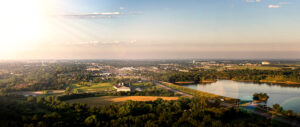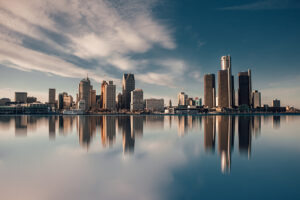
Real estate trends in the Midwest states—particularly Missouri, Indiana, Kansas, Illinois, and Michigan—carry the same narrative being told in the rest of the country. Low housing supply and high housing demand are driving up real estate prices. It’s a great opportunity for investors. But what sets the Midwest apart from much of the country is a strong drive for new construction in a warming real estate landscape.
“Since there isn’t a lot of inventory,” said Jeremy Moore, Sharestates’ Midwest regional sales director, “new construction is growing at a great rate.”
St. Louis, for instance, is expanding west. There’s a lot of land outside the city that could be developed. There is also a fair amount of new construction taking place northwest and southwest of the city. Developers are buying up the land and building new residential communities, which is one of the reasons St. Louis is a great place for real estate investment in 2022.
Row Houses Are Popular in St. Louis, Missouri
Leaders in St. Louis, Missouri desire to rebuild the city after a slow dwindling of the population over the years. In 1950, there were more than 850,000 people living there. In 2020, the population was just over 300,000. Moore believes the city’s efforts will lead to opportunities in commercial and residential real estate within the city. Specifically, multi-family and mixed-use development should see a surge.
Another trend is row houses.
“They’re trying to build as many houses as they can inside a small area to maximize land space,” Moore said. “They’re trying to rejuvenate the inner-city neighborhoods and suburbs.”
To that end, investors are picking up rundown properties and rehabilitating them. St. Louis also has several opportunity zones. These two things mean investors are earning big rewards revitalizing decaying neighborhoods. St. Louis is moving up and real estate investors are on the front line of what could be one of the greatest comebacks in municipal history.
New Construction in Detroit, Kansas City, and Indianapolis
Kansas City and Indianapolis are moving in the same direction as St. Louis. Rowhouses, opportunity zones, and neighborhood revitalization are in the cards for those cities. Detroit, too, is growing by leaps and bounds.
Detroit was hit hard in the 2008-09 financial crisis. In the 1950s, Detroit was a thriving city. The auto industry was booming, and MotownMoTown Records turned the city into a cultural center as well as a thriving community for the musical arts. After the financial crisis, Business Insider called it a ghost town. Houses were empty, buildings were abandoned, and people were leaving the city in droves. About five to seven years ago, city leaders began to push for new development.
“Now,” Moore said, “Detroit is growing like wildfire inside the city. They’re building commercial infrastructure, investors are picking up fix-and-flips, and there is a lot of residential rehab going on. They’ve done an excellent job of restoring the city.”
There’s still a lot of opportunity in Detroit today. There’s room for real estate investors to buy up parcels for new construction as well as buy rundown houses in neighborhoods to fix and flip.
In Detroit, Kansas City, and Indianapolis, investors have a choice—build from the ground up or invest in rehabbing properties that need a facelift.
 Fix-and-Flip Opportunities in Detroit and Chicago
Fix-and-Flip Opportunities in Detroit and Chicago
Chicago is a different story. In many ways, it’s like New York City. Property rehabilitation is always happening somewhere. Fix-and-flips are a huge opportunity.
One of the big trends is investors buying properties and expanding them. They’re taking single-family residences and turning them into duplexes and fourplexes or taking fourplexes and transforming them into six or eight units. In some cases, they’re taking entire apartment buildings and building onto them, adding amenities, and growing them into larger communities.
The population is growing. However, while there are more families looking for housing, the families are smaller. So, people don’t need large living spaces. Communities need more living spaces that are smaller. And open floor plans rule the day.
“They’re not a big need for big yards,” Moore said. “It’s more about buying the best house you can get for the best price.”
There are also great opportunities for mixed-use properties. For instance, a single-family residence built on top of a restaurant. It maximizes real estate, makes it more valuable from a community-development standpoint, and appeals to different types of real estate buyers.
Smaller cities like Columbus, Cincinnati, and Indianapolis might also have those opportunities, but you’ll find more single-family residential opportunities in the mid-sized cities as opposed to the larger cities like Chicago and Detroit. Investors who are familiar with the local real estate landscape and trends will have a better chance of maximizing opportunities.
Rentals Are a Big Opportunity in Large and Small Cities
Housing prices are still not favorable to Millennials and younger families. That means there is a huge rental market, whether you’re in St. Louis, Detroit, or Chicago.
“Older Millennials are transitioning into buying homes,” Moore said, “but for the last five or 10 years, they weren’t buying houses.”
Rising house prices, low supply, and high demand mean there isn’t enough housing for everyone to buy. It also means that some people are priced out of the market. Both of those factors are driving demand in the rental market. This is a golden opportunity for investors in every community. If you don’t want to build from the ground up, or can’t afford it, and you can’t get financing for a fix-and-flip, there’s always the buy-and-hold strategy with positive cash-flow properties.
All throughout the Midwest, rental properties are on the rise.
Where To Find Real Estate Investment Opportunities in the Midwest
Residential development is booming, especially in the smaller towns with room to grow. Land outside of the urban areas is ripe for building and development, and developers in these smaller towns are taking advantage of it.
Commercial development is also taking place in these towns. In Shaw Park, a suburb of St. Louis, developers are building out office space, condos, apartment complexes, villas, and more, to attract people back into the city. On top of that, the city’s Major League Soccer franchise is building a state-of-the-art stadium that will seat 22,500 fans. These developments will likely attract new residents to the city.
“The best investment opportunities right now,” Moore said, “are in fix-and-flips and rentals.”
Unless you’re building outside the city, there’s no room for new development unless you’re knocking something down and building from the ground up. That’s what some developers in St. Louis and Indianapolis are doing. They’re knocking down homes with large lots and building two units on the property.
Investors interested in getting in on the row house development shouldn’t count on them as rental properties. Moore said they make better single-family residences for home buyers.
On the north side of St. Louis, what locals call the North Corridor, there are rundown properties that can go for $50,000 or $60,000. A $30,000 or $40,000 investment can turn them into $150,000 properties. These are the neighborhoods in every Midwest city that Moore recommends for serious investors looking to maximize ROI. Properties can be fixed and flipped, rented out for cash flow, or demolished and replaced by a better property with amenities that appeal to today’s home buyers.
In terms of affordability, Moore recommends St. Louis, Indianapolis, and Kansas City as opposed to Chicago or Detroit. The home values are drastically different. In the smaller cities, purchase prices are in the $150,000 to $200,000 range. In the larger metro areas, it’s more like half a million dollars or more. Still, for investors that have the capital, Chicago and Detroit can be lucrative, especially for fix-and-flips and repurposed real estate.
In short, the market is wide open with flexible options for real estate investors. Ground-up developments are hot outside of smaller towns on the sprawl. Fix-and-flips are hot in the larger cities and mid-sized cities. Rentals are hot in the smaller cities. Investors are buying up properties that need to be rehabilitated and flipping them or renting them depending on their personal investment strategies. In areas where raw land isn’t available, investors are buying properties, knocking them down, and rebuilding to market. The biggest challenge, due to the competitive nature of the business, is finding properties at the right price.
What are the prospects for real estate investors for the next few years?
“I don’t see it slowing down any time soon,” Moore said. The housing inventory isn’t likely to change, and demand will likely go up. Interest rates will probably go up incrementally, which will benefit rental property owners. Anywhere you look in the Midwest, real estate investors have their pick of opportunities. It’s an open bar with every flavor of drink.
Are you a real estate investor looking for your next big opportunity in the midwest? Get in touch with Jeremy Moore today.



